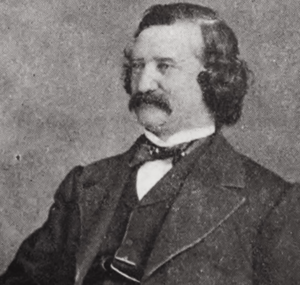Thomas Hoyne facts for kids
Quick facts for kids
His Honor the Mayor
Thomas Hoyne
|
|
|---|---|
 |
|
| Mayor of Chicago (disputed) | |
| In office March 1876 (not allowed to take office) |
|
| Preceded by | Harvey Doolittle Colvin |
| Succeeded by | Harvey Doolittle Colvin |
| United States District Attorney for Illinois | |
| In office 1853–1855 |
|
| Succeeded by | position abolished |
| United States District Attorney for the Northern District of Illinois | |
| In office 1855–1857 |
|
| Preceded by | position established |
| Succeeded by | A.M. Herrington |
| United States Marshal for the Northern District of Illinois | |
| In office 1860–1861 |
|
| Preceded by | Charles U. Pine |
| Succeeded by | Joseph Russell Jones |
| Cook County Probate Justice of the Peace | |
| In office 1845–1848 |
|
| Succeeded by | position abolished |
| City Clerk of Chicago | |
| In office 1840–1842 |
|
| Preceded by | William H. Brackett |
| Succeeded by | James Curtiss |
| Personal details | |
| Born | February 11, 1817 New York City |
| Died | July 27, 1883 (aged 66) Carlton, New York |
| Political party | Independent |
| Spouse | Leonora Maria Temple |
| Children | 7, including Frank G. Hoyne |
| Residences | Chicago, Illinois |
| Signature | |
Thomas Hoyne (born February 11, 1817, died July 27, 1883) was an important figure in Chicago's history. He was elected Mayor of Chicago in 1876, but a court later said his election was not valid. Before this, Hoyne held many important jobs in government at both the state and city levels.
Contents
Thomas Hoyne's Life and Work
Thomas Hoyne moved to Chicago in 1837. He decided to stop working in business and instead studied law. By 1839, he was allowed to work as a lawyer.
Early Roles in Chicago
In 1840, Hoyne was elected as the City Clerk of Chicago. This job involves keeping official city records. Later, in 1853, he became the United States District Attorney for Illinois. This means he was a lawyer who represented the U.S. government in court. Six years later, he became a U.S. Marshal for northern Illinois. A U.S. Marshal helps enforce federal laws.
Helping Chicago Grow
Thomas Hoyne was very involved in making Chicago a better place. In 1863, he traveled to New York and Boston to find a special lens for a telescope. This telescope was for the Old University of Chicago. In Boston, he bought a large 18½-inch lens from Alvan Clark. This lens was for the Dearborn Observatory. At that time, it was the biggest telescope of its kind ever built.
By 1866, Hoyne helped start the Chicago Astronomical Society. He also worked as the secretary for this group. After the terrible Great Chicago Fire in 1871, Hoyne helped create a free library in Chicago. He was on its board of directors and even wrote the first history of the Chicago library system.
The Disputed Mayoral Election
In 1875, Chicago changed its city laws. New rules said city elections would happen in April, not November. The mayor at the time, Harvey Doolittle Colvin, thought his term would last until the new April elections. The city's new rules did not clearly say his term was extended. They also did not call for a special election for mayor during the time between November and May.
The 1876 Mayoral Race
In April 1876, an election was held. Neither the Republicans nor the Democrats chose a candidate for mayor. Thomas Hoyne ran as an independent candidate. He received a huge number of votes, getting 33,064 out of 40,000 votes. He was then declared the new Mayor of Chicago.
However, Mayor Colvin refused to leave his office. The city's money manager supported Colvin. Even though Hoyne led city council meetings and gave a speech, a court later said his election was not valid. Colvin continued to be mayor until a special election was held on July 12, 1876.
Later Life and Legacy
Thomas Hoyne died on July 27, 1883. He was killed in a train crash near Carlton Station. He was buried there.
Today, Hoyne Avenue in Chicago is named after him.
Thomas Hoyne's Family Life
On September 17, 1840, Thomas Hoyne married Leonora Temple.
His younger brother, Philip Augustus Hoyne, also held important jobs in Chicago. He was the Clerk of the Recorder's Court and a U.S. Commissioner for Illinois. He also served on the City's Board of Education and was its president for two terms.

